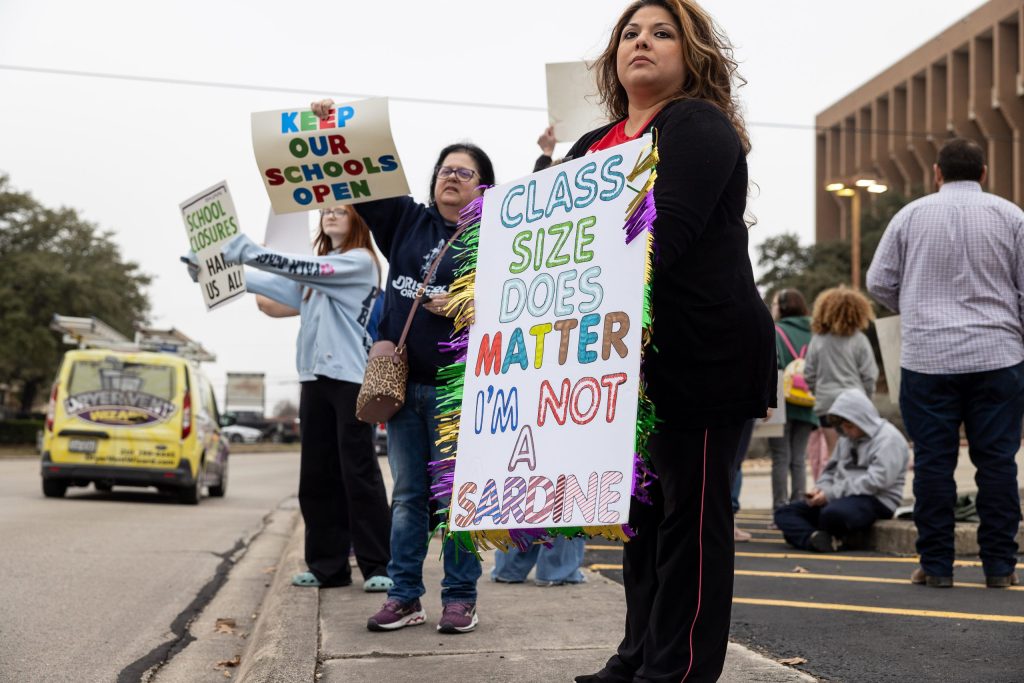North East Independent School District unanimously approved the closure of three schools and the adjustments of certain schools’ boundaries — despite parent and community member protests — to offset a $39 million budget deficit.
Minutes before the meeting took place, parents and members of NEISD Community Advocates, a group fighting against school closures, rallied in front of the district’s office with cardboard signs demanding board members delay or reject the vote on school closures.
“Your fight! My fight! We won’t back down!” was one of the chants parent activists hurled at passerby in cars or those who walked into the NEISD office building.
But despite the protests and District 2 Trustee Tracie Shelton motioning to delay the vote, Wilshire Elementary School, Clear Spring Elementary School and Driscoll Middle School will close by the start of the 2025-2026 school year. Students of those schools will be “absorbed” by other NEISD schools.
Boundary changes
Wilshire students east of Corinne/Harry Wurzbach Parkway will go to East Terrell Hills Elementary, and those west of Corinne/Harry Wurzbach Parkway will go to Northwood Elementary. The district estimates East Terrell Hills will go from 54% utilization to approximately 61%, and Northwood will go from 51% to approximately 68%.
Clear Springs students north of Wurzbach Parkway will go to El Dorado Elementary, the eastern portion south of Wurzbach will go to Royal Ridge Elementary, and the western portion south of the parkway will go to Serna Elementary. El Dorado is estimated to go from 53% utilization to 65%, Royal Ridge will go from about 60% utilization to 68%, and Serna’s utilization is estimated to jump from 39% to 53%.
Driscoll students north and east of Thousand Oaks Drive will go to Harris Middle School, and students south and west will go to Garner Middle School. The district estimated Harris’ utilization will go from 51% to 74%, and Garner’s is estimated to go from 61% to 70%.
Transportation concerns
Among concerns of the new schools’ locations, their performance, student support and school choice, it was transportation that was one of the most cited issues for parents.
During the meeting, Chief Operations Officer Deb Caldwell said there would be increased distances for some of the students that have to move schools.
While bus route lengths will remain about the same for Clear Spring and Wilshire, students from Driscoll will see a 15 to 20 minute increase on their school routes, Caldwell said.
Melanie Trevino is a mom of three: an eighth- and a seventh-grader currently enrolled at Driscoll and a 26-year-old that previously attended that middle school. Driving her kids to Garner, which is where her kids would be transferred to, would make her commute more than 20 minutes one way.
“My drive right now is four minutes,” Trevino said before the meeting started. To get to Garner, the fourth closest middle school to her house, Trevino would have to cross an often shut down railroad track and get on the other side of the I-410 access road.
‘Decades in the making’
Superintendent Sean Maika blamed the need to consolidate schools on declining birth rates, lower enrollment, the rise of charter and private schools and a lack of “significant” state funding.
Driscoll, Wilshire and Clear Spring were originally recommended for consolidation on the recommendation of NEISD’s Long-Range Efficiency Committee during a December board meeting. The three schools were singled out because they were the most expensive to operate and had enrollments below 50% of the schools’ capacities.
But Trevino says that low enrollment is “one of the great things” about Driscoll, because that means students there get to participate in all kinds of programs and extracurricular activities.
As of 2021-2022, NEISD had an enrollment of 59,445, a 17% decrease from the 2014-2015 school year, which saw an enrollment of 67,971.
“It’s been decades in the making,” Maika said during the meeting. “It happened over time.”
The closures and boundary modifications are part of an effort by NEISD to cut through a $38 million budget deficit, brought on by historic 2023 raises NEISD employees received. During that meeting Maika said the district planned on finding a way to save $10 million each year for the next three years to offset a shortfall estimated to be more than $39 million at the time.
Instead of a raise last year, the board approved a one-time 1.5% retention bonus to full time teachers and librarians in November, a move that cost the district $6 million.
“Hope is not a strategy… There is this belief that a windfall of money is potentially headed to education. I don’t believe that,” Maika said during the Monday night meeting.
Before taking a vote, the board heard from 30 NEISD parents, students and community members asking them to delay the vote to consolidate or vote no.
Criticism during the public hearing included that NEISD was rushing the vote, having only publicly announced the consideration of closing schools Dec. 9.
“If this has been decades in the making, why has this decision been so rushed?” a Driscoll mother identified as Jill, asked the board.
One Driscoll middle schooler asked the board to be more transparent. “You talk about transparency but you are doing everything but being transparent. What are you hiding?”
Other speakers demanded trustees have a plan for the vacant buildings and to study the impact to economically disadvantaged families and families with special needs students.
One mother asked why none of the information shared by the district through their website and during community meetings after the closures were announced for consideration in December.
The Monday night meeting did not have a Spanish interpreter or presentations transcribed in Spanish.
Complaints were many, but most speakers asked the board for one thing.
“Delay the vote.”
What happens to closed schools?
San Antonio ISD closed 15 schools last year and is currently accepting community input on how to repurpose the closed facilities. Fine arts programs, early childhood education and green spaces are currently the highest voted for developments by SAISD community members.
SAISD is still determining what to do with the closed school buildings, including looking to secure partnerships with outside organizations.
But community members of NEISD may have to wait a while before the district decides how to repurpose the three closed schools.
During the initial December meeting when school closures were first discussed, the district’s Executive Director of Finance and Accounting Susie Lackorn said it was too soon to tell how the closed buildings would be used in the future since there are many “moving pieces” in the consolidation process, and Maika stated no new programs would be created, but there might be a shift in existing programs.
“Could we have communicated this better to you? I think we could have, and for that I’m sorry” said District 6 Trustee Terri Chigdey to the parents before taking the vote that will effectively close three schools.
“But no matter how we did it … It doesn’t change that we lost 12,000 kids, and we have the same number of buildings and the same number of facilities,” she said.








